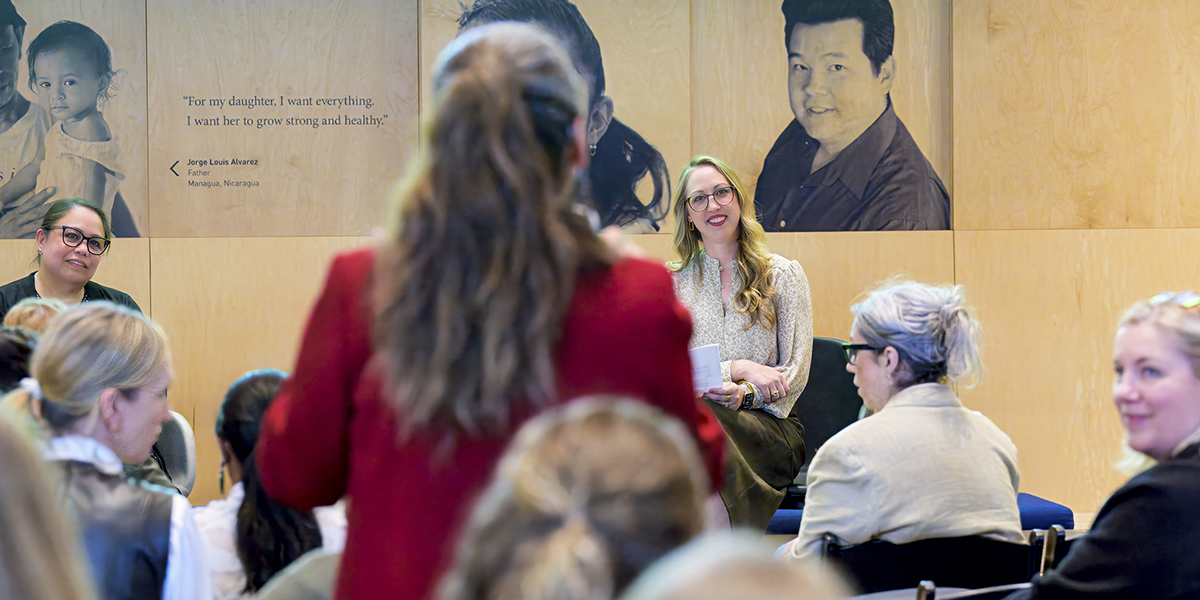Written by Brittany Richardson-Don – Photo by Kal Visuals
Most of us would agree that social connections play a significant role in our sense of well-being and the way we impact the world around us.
Rooted in something social psychologists have been talking about for decades – the inherent human need to belong – a sense of belonging is a feeling of being known and accepted by those around us. But “true belonging,” according to Brené Brown, “only happens when we present our authentic selves to the world.”
What about at work?
You’d be forgiven for performing the mental gymnastics necessary to acknowledge your deep need to belong outside of work, while dismissing that same need in a work context. Afterall, we’ve been conditioned to treat our work life and personal life as separate things. However, the realities of 24/7 connectivity, rise of remote work, and better understanding of our social proclivity, suggest that authenticity and vulnerability is just as relevant and, in fact, highly strategic in the workplace.
In the words of Lions & Tigers EVP of People + Operations, Terry Rice, “Giving permission for people to show up as they are, without explanation, opens the door for a culture shift with surprising outcomes.” There is opportunity for deeper connection, better collaboration, and greater work satisfaction when we allow – even expect – the whole person to show up.
We’ve identified (5) ways that authenticity at work is a strategic advantage not only for our team, but for our clients.
1. Enables stronger relationships
There’s a tendency in our production-driven world to focus on the most efficient path to an outcome, which oftentimes means optimizing relationships to the point that they are transactional. This is especially true in the consulting world, where talent is regularly onboarded for a specific service or work product. While perhaps more straightforward and less effort, significant ‘soft’ value is left on the table.
Research on workplace performance is clear about the benefits of strong workplace connections, including increased loyalty, creativity, collaboration, and empathy. Empathy – when colleagues see, understand, and extend grace to one another – is essential for making the workplace more humane and the work more compelling.
We saw an example of this during a recent virtual “Show & Tell” call. As a consultant presented a client win, she mentioned his reputation as an austere personality and the pains she took to win his confidence. The turning point, she said, was one of their regular Teams calls, when she could hear his young son babbling in the background. “We have this tendency to elevate these high-power clients as above ourselves, but they’re just people.” Realizing this made the work she did for her client more personal, tangible, motivating. Instead of taking a task off his plate, she was giving him time back to spend with his son.
2. Empowers healthy boundaries
Each member of Lions & Tigers’ diverse team has opted into this non-traditional work environment because of a need or desire for greater flexibility. When we enable an environment where clients and consultants see one another as people with rich, full lives outside of work, it’s easier to set and respect boundaries on working hours and availability. Propping up separate personas and erecting false compartments of work activities and personal activities isn’t productive. More importantly, there is immense value in being fully present in whatever activity you’re engaged in and acknowledging that each activity is important to you.
One way we reinforce this value is with our now-legendary email signature, which reads:
My work and family life require flexibility from me, so my hours may not be your hours. No need to reply until your schedule allows.
These two little sentences have received outsized attention from people throughout our ecosystem. Each and every email from a Lions & Tigers account carries this gentle boundary enforcement and an invitation. It communicates that we see the tremendous value of pursuing full, uncompromised lives, and we think those we work with are worthy of the same. We’ve watched with pride as our clients and peers take our lead and add the simple declaration to their signature, reinforcing that each and every person has a right to be more than an inbox monitor.
3. Contributes to inclusive innovation
A common pitfall within high-impact teams is the tendency for individuals to doubt the adequacy of their ‘true self’ and begin to imitate those around them. “The irony,” according to Brené Brown, “is that we attempt to disown our difficult stories to appear more whole or more acceptable, but our wholeness … actually depends on the integration of all of our experiences, including the falls.”
Disowning our stories is a loss for both the individual and the team. Instead of a rich space where unique lived experiences, perspectives and fresh ideas are shared, refined and evaluated, the collaborative space becomes a bland echo-chamber. On the other hand, when we show up authentically, confident in the inherent value and worthiness of our perspective, we’re more inclined to think critically. To push against the boundaries of the status quo and the perceived norms of leaders can feel risky, but it opens the door for a broader range of solutions and greater impact.
For 20 years, one consultant was “the English major among the Engineers” at Microsoft. She felt like an outsider – a generalist among specialists, a non-technical person among the high-tech elite. Over time, she came to realize that they needed her precisely because she was different. She could do things her engineer colleagues couldn’t – write, tell stories, see the big picture, and attend to the human side of business – which were essential for getting their work into the world. This realization shaped that stage of her career and helped her embrace the unique “difference” that contributed so much to her teams.
4. Promotes a growth mentality
If you aren’t showing up as yourself, the root of your success or failure is harder to identify and amplify. Success, when you’re imitating others or going through the motions, rings empty and may even contribute to impostor syndrome. After all, it isn’t really ‘your’ success. Responding to failure can be even more disorienting.
On the other hand, showing up authentically gives more context to feedback. Positive recognition for your work contributes to confidence because there is no ambiguity between who you are and what you produce. Likewise, in the case of struggle or failure, you have more to work with when figuring out how to motivate, improve, or change performance or behavior. Vulnerability creates the conditions for deeper learning and growth.
For one consultant, this growth opportunity was born out of deep discouragement. Just a couple weeks into a new project, she wasn’t happy with her performance and was sure her client wasn’t either. Following the suggestion of a colleague, she took a risk and asked her client for feedback at their next 1:1. To her surprise, the client’s assessment highlighted a stark mismatch between their perceptions. The client expected the new project to take time to ramp up and was, in fact, extremely pleased with her work. Looking back, what was hardest was not knowing where she stood. Initiating feedback made this consultant vulnerable, but – as she sees it – every opportunity to sit down with someone and get candid feedback, whether good or bad, is a chance to lean into a situation, figure out what could be better, and grow. This situation reassured her confidence, reminded her to be kinder to herself, and reinforced her commitment to growth.
5. Helps refine Highest & Best Use
The unique value that our consultants bring to the table for clients is as much rooted in their story as in their skills.
Personal experiences shape the way we access and use our hard skills in the workplace and how we show up in our “Highest & Best Use.” The idea of Highest & Best Use comes from real estate where a property is assessed according to its greatest potential. We see a strong connection between a person’s willingness to let their values, goals, backstory, and layers of identity inform their work and their ability to live into their highest-and-best use. Showing up authentically keeps us connected to the values that drive us in and beyond work. We are better able to say yes to opportunities that align with how we make our greatest contribution in the workplace, and say no to those that don’t. The result is a win-win for our clients and consultants who, in partnership, leverage one another’s holistic experiences and strengths to drive high value impact. This focus is what sets apart the change-makers from the merely competent.
Creating an open channel between skills deemed relevant to the workplace and values traditionally viewed as irrelevant is where most of us find that sweet spot and can deliver exceptional work product.
We see this lived out in the experience of a marketing-and-product-manager-turned-licensed-psychologist. In the middle of a successful career in corporate America, she made the unusual decision to return to school and pursue her doctorate in psychology. She knew that for all her success in the tech world, she had more to offer her clients. Now a licensed psychologist, this consultant has carved out a unique and thriving practice at the intersection of her two passions, helping blend the worlds of business and emotional intelligence to strengthen leaders and teams in a way few can.
A post on authenticity in the workplace wouldn’t be complete without acknowledging that it isn’t easy. Maintaining the status quo of guarded professionalism (at best) or muted anonymity (at worst) can feel less risky than sharing our emotions, fears, and desires with work partners.
But the potential on the other side is worth the risk.
The next post in this series will explore actionable cultural and policy steps that organizations and individuals can take to encourage authenticity in your own organizational ecosystem.
Let us be your Ambassadors of Authenticity
Lions & Tigers has been committed to authenticity from day one. Our mission is to make work ‘work’ for everyone, including our clients. In addition to curating a flexible, high-impact talent pool, we are leveraging what we’ve learned about creating a culture of authenticity to equip and empower our clients to understand and succeed in the future of work. We’d love to talk to you about what this could look like for your company.
Next steps
- Learn more about tapping the full value of your workforce
- Talk to us about Future of Work practices
- Stay up-to-date with the Lions & Tigers newsletter
About the Author
Lions & Tigers Consultant, Brittany Richardson-Don, has pursued an eclectic career path through nations and languages in which writing has been one of the only constants. She believes words have power and seeks to use her writing to cut through the noise and bring forth stories that captivate, inform, and inspire progress. When she’s not at the keyboard, she’s spending time with her husband and two kids, reading about education, social justice, and parenting, getting outside, and serving in the community.








0 Comments